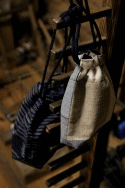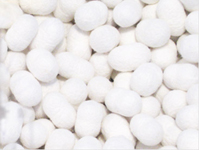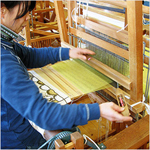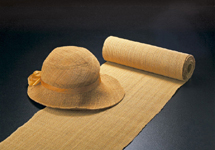
photo by Tohoku Bureau of Economy, Trade and Industry
|
UETSUSHINAFU |
| (Yamagata & Niigata) / cloth, bag, cap, scarf, zori |
| UETSUSINAFU is counted amongst the three major ancient woven crafts in
Japan. It begins with the peeled bark a tree that was cut down, next to
make thread which are all done by hand. It will take one year to finish
the yarn spun out from the skin firm. It was designated a Traditional Craft
by the Japanese Government in 2005. |
| |
photo by Tottori Prefectural Government HP, Tottori Traditional Arts &
Crafts information TORINET
photo by Tottori Prefectural Government HP, Tottori Traditional Arts &
Crafts information TORINET-Photos library
|
YUMIHAMA GASURI |
| (Tottori) / kimono, bag, cover, table center |
| It made its debut during the Edo Period, and was made by housewives of
farmers. It is portrayed by its simplicity of design, mild texture, and
contrast of its own navy blue and indigo. It has excellent moisture absorption
and heat retention. New products such as table cloths have earned a good
reputation. This was designated a Traditional Craft by the Japanese Government
in 1975. |
| |
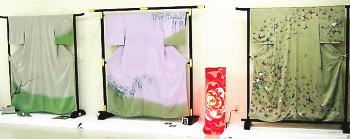
photo by Tottori Prefectural Government HP, Tottori Traditional Arts &
Crafts information TORINET |
DAISEN YUUZEN ZOME |
| (Tottori) / kimono, cover |
| This is produced by combining both modern and traditional techniques. The designs and motif are painted into the natural fibers such as cotton or silk and results in very gorgeous and beautiful textiles. It is designated a Tottori specified technology. |
| |
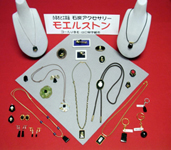
photo by Yamaguchi Prefectural Government HP, Yamaguchi Brand Museum |
MOERUSUTON |
| (Yamaguchi)/accessories |
| Moerusuton is accessories that was made by coal. It is the handmade with
gemstones in the coal. It is New brand product of Yamaguchi. When subjected
to a design in mother-of-pearl inlay with an embedded abalone, hit the
light of the rainbow colors from the brilliance in the jet black. |
|
photo by Ehime Prefectural Government HP, Ehime good products picture book |
NOMURA SILK |
| (Ehime)/fablic, yarn |
| It is trademaked name "Camellia(white camellia)". It have a received
a high reputation both at home and abroad for a long time. It’s the biggest
feature is Bulky and Shiny. It has been used to restore the NOU costume.
It is also a purvey of raw silk of Shikinen Senguu of tha Grand Shrine
Ise that is done once in 20years. |
| |
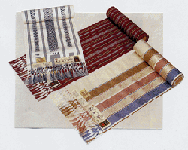
photo by Fukuoka Prefectural Government HP, Traditional Craft page |
HAKATA ORI |
| (Fukuoka)/fablic, kimono |
| It was reported by Hakata merchants who went Sou in 760years ago. HAKATAORI
is a plain weave. It is said that good qulity of silk with sound "Kyu-Kyu"
. Its sound is synonymous with high quality of HAKATAORI. Its mainproducing
area is Fukuoka city. It was designated as a Traditional Craft by Japanese
Government in 1976. |
| |
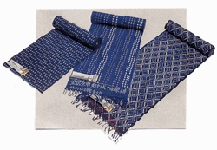
photo by Fukuoka Prefectural Government HP, Traditional Craft page |
KURUME GASURI |
| (Fukuok)/fablic, kimono |
| Den Inoue who is woman in Kurume city in 19century devised. Pattern of
Hihaku(flying white) with indigo dyeing is known well aroud the world as
a representative national costume of Japan now. Its main producing areas
are Kurumecity and Hirokawa town. It was designated as a Traditional Craft
by Japanese Government in 1976. |
| |
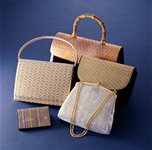
photo by Institute of Saga Prefectural Tourism Federation |
SAGA NISHIKI |
| (Saga)/fablic, kimono, bag, zori, neck-tie |
| It was devised by wife of the 9th Kashimanabeshima lord. She has idea from
the pattern of cell. It has geometric, brilliant and delicate patterns
with weven gold, silver and laquer to warp, silk to weft. It has been acclaimed
by the Japanese-English Exhibition which was held in England in the Meiji
Period. It is also evaluated from abroad as acme of Japan hand-woven still
now. |
| |
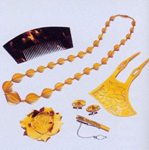
photo by Nagasaki Prefectural Government HP, Nagasaki Traditional Craft
Page and Toukei kids |
 NAGASAKI BEKKOU NAGASAKI BEKKOU |
| (Nagasaki)/accessories, hair ornament |
| It is a craft that represents the Nagasaki city with history and romance.
Nagasaki city is the production center of tortoiseshell in Japan. It is
said processing technology has introduced from China in the first half
of the 17th century. Mainly pfroduction are accesories and decolating goods.
It was designated as a Nagasaki specified technology craft in 1991. |
| |
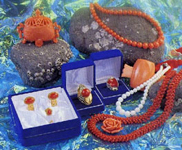
photo by Nagasaki Prefectural Government HP, Nagasaki Traditional Craft
Page and Toukei kids |
 GOTOU SANGO GOTOU SANGO |
| (Nagasaki)/accessories, ornament |
| In the Orient, coral has been prized as one of the jewels with gold and
silver for a long time. Also in Europe, it has been used habitually as
a talisman amulet. GOTOU SANGO is said to have starteda in the early Meiji
Period. Products come wide variety. It was designated as a Nagasaki specified
technology craft in 1991. |
| |

copyright: |
 NANBU HISHI ZASHI NANBU HISHI ZASHI |
| (Aomori) / neck-tie, bag, tablecloth, reputation, zori |
| NANABU HISHI ZASHI was born in Southern Aomori Prefecture more than 200
years ago. HISHIZASHI means diamond embroidery. Even-numbered stitches
through the te hemb fabric gives it an unusual character. There are various
geometric patterns. |
| |

copyright: |
 TSUGARU SAKIORI TSUGARU SAKIORI |
| (Aomori) / bag, tablecloth, coat |
| SAKIORI is called Sakuri in the Tsugaru area. Sakuri was a textile used
by cloth that was torn and then woven. The attractiveness stems from the
deeply aged coloring and torn cloth that produces a unique texture. |
| |

copyright: |
HACHIMANTAI GEOTHERMAL DYEING |
| (Iwate) / handkerchief, shirt, original clothing, scarf |
| Unique colored products that are created in addition to a staining method
using geothermal steam in a special way and various colored inks. Especially,
"Jio coloring" was developed from 1997, and is a popular technique
utilizing exclusive selected designs from materials and fabrics. |
| |

copyright: |
NANBU KODAI KATAZOME |
| (Iwate) / table center, bag, obi, kimono |
| The contrast of the pattern from basically deep blue is excellent. All
goods are handmade. In 1980, it was designated as a craft from the country.
|
| |

copyright: |
NANBU SHIKON ZOME/AKANEZOME |
| (Iwate) / cloth, kimono, table center, bag, obi, purse, wrapping cloth |
| It originated before the kamakura Period. A form of plant dyeing. SHIKONZOME
uses purple roots, Akanezome is dyed with akane. Patterns devised have
reached 800 designs. |
| |

copyright: |
OITAMA TSUMUGI |
| (Yamagata) / kimono, bag, tablecenter |
| Produced in the OITAMA region. OITAMA TSUMUGI consists of "SOUMOKU
SOME", "YOKOSOU KASURI", "TATEYOKOHEIYOU kASURI",
"ITAJIMEKOGASURI". It was designated a Traditional Craft by the
Japanese Government in 1976. |
| |
 |
 MURAYAMA OOSHIMA TSUMUGI MURAYAMA OOSHIMA TSUMUGI |
| (Tokyo) / Kimono |
| MURAYAMA OOSHIMA TSUMUGI originated during the mid-Edo Period. It is woven
with a unique hand loom and has no front or back. It was designated as
a Tokyo specific technical craft in 1967, and designated as a Traditional
Craft by the Japanese Government in 1975. |
| |

copyright: |
 HONBA KIHACHIJOU HONBA KIHACHIJOU |
| (Tokyo) / Kimono |
| KIHACHIJOU was produced in Hachijo-jima. It has a vertical stripe pattern
that combines the three colors of yellow, birch, and black. Plaid is a
typical pattern. The fabric is hand-woven. The color doesn’t fade even
after many years. It was designated a Tokyo specified technical craft in
1982, and designated as a Traditional Craft by the Japanese Government
in 1977. |
| |

copyright: |
EDO TSUMAMI KANZASHI |
| (Tokyo) / kanzashi, hair ornament |
| TSUMAMI KANZASHI is produced mostly in Edo even nowadays. It was born during
the beginning of the Edo Period. It was made in Kyoto and further developed
in Edo. By cutting small squares of thin cloth, folding, and combining
them, flowers and bird patterns can be created. This technique is called
"Tsumami zaiku (work)". It was designated a Tokyo specified technical
craft in 1982. |
| |

copyright: |
OJIYA CHIJIMI |
| (Niigata)/kimono |
| After weaving, it is made to wrinkle in hot water. This cloth is used for
Summer kimono that easily absorbs water and has excellent breathability.
It is considered an important Intangible Property and was designated an
intangible cultural heritage by UNESCO in 2009. It was named a Traditional
Craft by the Japanese Government in 1975. |
| |

copyright: |
 KOUSYUU INDEN KOUSYUU INDEN |
| (Yamanashi) / bag, pouch |
| It's a product with a lacquered pattern on leather deer hide. Inden originated
in India as a decorative leather. Now Kousyuu Inden is a technique only
found in Japan. It was designated a Traditional Craft by the Japanese Government
in 1987, and It was designated a Yamanashi specified technology craft in
1994. |
| |

copyright: |
NIKKOU GETA |
| (Tochigi) / geta |
| It is mixed zori that is used bamboo skin and geta that is stand by trees.
It can be feel cool in summer and warm in winter. It was designed as a
Tochigi specified technical craft. |
| |

copyright: |
NAGOYA YUZEN |
| (Aichi)/.kimono |
| This technique was talked about by the master of YUZEN who came from Kyoto
or Edo city. Its feature is a mystery with SHIBUSA in monochrome with light
and shade color control. It was designated a Traditional Craft by the Japanese
Government in 1983. |
| |

copyright: |
IGA KUMIHIMO |
| (Mie)/obi cord, string, neck-tie |
| Its debut is said to date back to before the Nara Period. Its popular technique
is a traditional trade from the Edo Period. It was designated a Traditional
Craft by the Japanese Government in 1976. |
| |

copyright: |
KAGA YUUZEN |
| (Ishikawa)/kimono, obi |
| Yuuzensai Miyazaki was thought to have been taught Yuuzen painting in Kyoto.
The technique is a mixture of mixed paint Kyoto type dyeing and Kaga. It
was designated a Traditional Craft by the Japanese Government in 1975. |
| |

copyright: |
KYOU KANOKOSHIBORI |
| (Kyoto) / kimono, bag, fashion accessories |
| Originated in India the technique of tie-dying was transmitted to Japan
during the early 7th century. It is unique method that renders a pattern
to areas which are not dyed. Each dyer has mastered only one specialized
technique so, many technicians are required to produce the product based
upon the design. It was designated a Traditional Craft by the Japanese
Government in 1976. |
| |

copyright: |
KYOU YUZEN・KYOU KOMON |
| (Kyoto) / kimono, bag , fashion accessories |
| Yuzen is a technique that produces a kimono dyed with painted color patterns.
Yuzen was created by Yuzensai Miyazaki and is portrayed by vivid color
and elegance. Komon is technique of dyeing that matured during the 17th
century. Komon is characterized by stylish and graceful patterns and colors.
These were designated as a Traditional Crafts by the Japanese Government
in 1976. |
| |

copyright: |
KYOU SENSU・KYOU UCHIWA |
| (Kyoto)/fan, decolating goods |
| SENSU was born in the beginning of the Heian Period. It was exported to
India or to European countries at the 13th century. Various kind goods
have been produced for incense burning, dancing, tea ceremony etc. UCHIWA
is type of Korean fan. It originated from the Palace Fan (GOSYO UCHIWA).
It is portrayed by its beautiful and elegant illustrations. Thesewere designated
as Traditional Crafts by the Japanese Government in 1977. |
| |
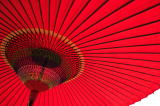 D.D.Revolution
D.D.Revolution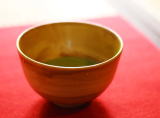

.jpg)
